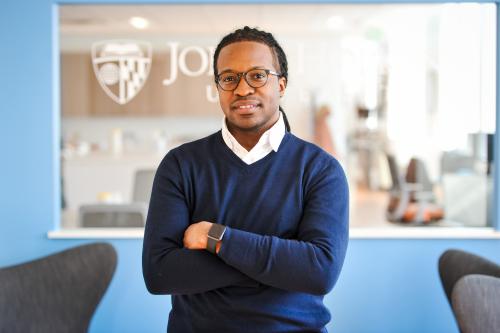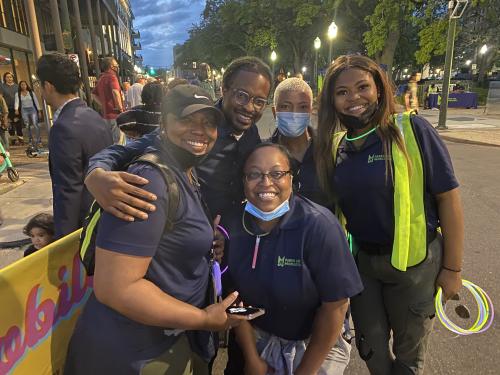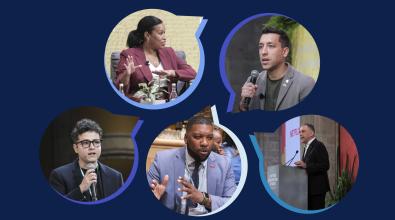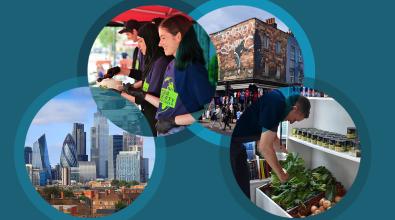Building trustworthy local government

Survey after survey shows a troubling plunge in trust in government. And while faith in local government ranks higher than other levels of government, local leaders know that in an era of misinformation and historic challenges, they have a lot of work to do to build stronger connections with residents.
Terrance DeShaun Smith thinks they won’t get far unless they change their thinking.
Smith says that the way local leaders talk about this issue too often puts the onus on residents to give their trust. It should be the other way around, he says: It’s on local leaders to build organizations that are trustworthy.
It’s something Smith knows a lot about, personally and professionally.
Growing up in Mobile, Ala., Smith noticed how government can destroy trust by doing harm: Packing too many people into the crowded housing project he grew up in, neglecting schools in Black neighborhoods like his, leaving a legacy of housing discrimination and segregation thanks to redlining.
Smith also has shown how government can earn trust and be a force for change. After building the prototype for Alabama’s first charter school, he took a job in Mobile local government leading the city’s innovation team. There, he found that trust was one of the most critical ingredients in transforming how the city handles blighted properties, recreational programming, business permitting, and more. And building trust was needed not only outside City Hall with residents and stakeholders, but also inside City Hall with agencies and workers.
Smith recently became a fellow at the Bloomberg Center for Public Innovation at Johns Hopkins University, where he is focused on advancing understanding of how local governments earn the trust of residents. The two-year engagement gives him an opportunity to build upon his work in Mobile by teaching a course on designing for trustworthiness in public institutions and by conducting global research into how local innovators across different cultures establish trustworthiness.
Bloomberg Cities recently caught up with Smith to learn more about his latest thinking.
What’s wrong with how you hear people talking about ‘building trust in government’ these days?
It places a lot of the work on the residents. We’re asking them to give us something: Give me your trust. Which is also telling them: I want you to be vulnerable with me. I want you to take a risk with me. But if you’re a resident, the question is: Why? Why do I need to give you my trust?
What we need is not more trust in government. What we need is more intelligently placed trust in trustworthy organizations.
That means we have to be prepared to hold the mirror up and say: This is who we are right now—and they don’t trust this. How do we rearrange what we are in order to be prepared to receive that investment?
I don’t think governments understand that. What I’ve seen, for the most part, is engaging residents in order to do a certain thing. And that’s what residents see: Here comes election season, they want me to trust them to get my vote. And then we don’t see you anymore until you want a thing done.
Why is trust important to public innovation?
Every day, innovation teams are asking city workers who’ve been doing these jobs for 10, 20, or 30 years to take a difficult journey with us, with a promise that on the other side everything will come out great. And they’re like: Mmmm, why would I do that? We can’t have innovation without trust. And we can’t have trust until we become trustworthy.
It’s not just for the sake of being trustworthy. It’s for the sake of having people share real issues with us, to take risks, and to foster innovative work in order to build the dynamic capabilities we’ll need to tackle whatever the next crisis is.
How, then, do we increase an organization’s trustworthiness?
It takes time. We have to embed trustworthiness into everything we do. So when we go out, we ask two questions: Does this action build or erode trust? And if it builds trust, let’s go. If it erodes trust—then is it worth it? Am I going to need that trust again, and how long is it going to take to restore it?
There are three signals of trustworthiness: Do people believe in the organization’s ability, humanity, and integrity? If any one of those legs has a wobble, you’ve got to address it.
Let’s unpack those. What do you mean by ability, humanity, and integrity?
Ability is: Can this organization actually do what they say they’re going to do?
Humanity is: Do they care about me—or do they care more about their own agenda?
And integrity is: Will they represent me and do what they said—even when I’m not there watching?
Organizations must live up to all three if they’re to be trustworthy. And it’s important to understand that all of this is based on peoples’ perceptions, so we want to provide clear evidence of our trustworthiness. We don’t want to be ambiguous in our ability, humanity, and integrity.
In government, we often hire people who have high levels of ability, but questionable humanity and integrity. It’s important as you’re building teams to understand what you have and what you lack.
What’s an example from your days in Mobile that shows this in action?
As part of the city’s response to youth-involved gun violence, the i-team was asked to create more fun and safe places for kids. That got us working with the Parks and Recreation Department, which had been neglected for years. The rec centers were horrible—you literally had buildings with gunshot holes in the front, the staff didn’t have uniforms or materials, and they were nervous to interact with some of the community members.
We went out and met with all the staff working in the centers. Most of the centers had very little programming for kids—there was space where kids could just come and play basketball or dominoes, but there was no rigor around meeting educational support or other needs in the community. The staff, though—you could tell in their voices that these people didn’t come to government just to sit around. They came to help people.
We brought them into design sessions, where they put their thoughts on sticky notes on the wall and then watched their ideas build and grow. Once they believed in the process, they started to talk to community members about what they need from recreation centers.
We had internal and external stakeholders working together to build a strategic vision for the department: “Fun and safe places where everybody is somebody.” The staff were adamant about those words. They felt that no matter where you come from, you should feel like you’re somebody, and that you belong in this space.
Much of the work you described is internal. What did engagement with residents look like?
That was gathering the heads of the independent league athletic teams and asking what needs they’re seeing in the kids, and how we could be a better partner. Then it’s the same conversation with the dance moms. And the arts community. And the people providing senior services. And we talked with the people who don’t come to recreation centers to understand why.
A lot of the staff had never had that level of engagement with the community. It was important for them to acknowledge that we, as a government, have not done all we need to in this area. We acknowledge that, and we’re here to change it. But we’re going to need your help.
How do you know the organization is trustworthy?
Your level of trustworthiness is what gets people in the door. We knew our recreation centers weren’t trustworthy because people weren’t showing up. Parents weren’t bringing their kids. Staff members were sneaking out of work or locking the door to prevent kids from coming in.
Now there’s this new energy around rec centers. We have STEM camps drawing over 500 people. We have centers that went from zero participants to bursting at the seams. And Parks and Rec events are now the hottest events in the entire city. They put on a food truck festival where the biggest complaint is that the lines are too long. To me, that’s a measure of success.
Parks and Rec essentially became a community engagement arm of the city, because it was the space where everyone felt welcome. Other departments started to see what was happening. The Special Events Department was folded into Parks and Rec, and the events are taking off. There’s an Art Walk that used to generate a couple hundred visitors. Now, 20,000 people show up.
You’re also starting to see groups that have been socially excluded brought into the center, with their cultures on full display. Our first Latin Fest drew over 28,000 people. We had our first Native American Fest and our first LGBTQ PRIDE Week. The success is because of all those who participated in the community sessions, and because they see themselves represented in the work.
Where is your research on trust headed next?
I’m researching how local governments design trust into organizational infrastructure and then strengthen that trust to ensure they’re delivering what residents need. I’m working with four cities across the U.S., Europe, and New Zealand.
I'm also looking to see how local leaders establish trustworthiness in different cultures, in different parts of the world. How do they pivot that into earning the trust? What does it look like to maintain trust? How do they leverage the trust that has been earned and gained—and when trust falls, how do they restore it? And how does earning trust impact a city’s ability to innovate?




